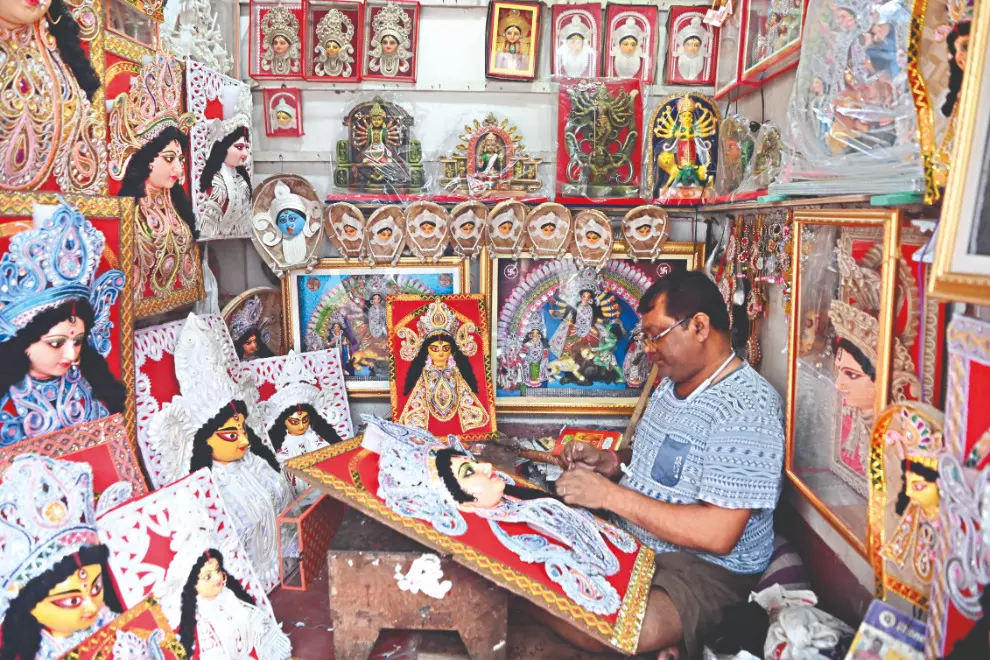Dressing the Goddess Tradition, Faith & Survival
With thermocol banned and shola cultivation dwindling, Kumartuli artists seek cost-effective substitutes to continue adorning Goddess Durga. Anindita Acharya tells their story

It’s almost lunch time, but artist Dipak Dey needs to complete one last floral motif on the Durga ornament before he shuts shop and heads home. The influx of vloggers at Kumartuli with cameras has certainly disrupted the working atmosphere for these artists, but Dey knows he must complete the design on time with just a few days left for Durga Puja. Just as the potters in Kumartuli are burning the midnight oil to finish their pending idols, the sholapith and daaker saaj artists, too, are working overtime to complete the goddess’s ornaments. Much like a Bengali bride who achieves her complete look only after wearing the ‘sholar’ crown, Goddess Durga’s pandal look is complete only once she is adorned with her ornaments and attires.
Decoration or ‘saaj’ in Bengali is the final stage in idol-making. It depends on the choice of clients and puja committees. A common confusion persists between sholar saaj and daaker saaj, as they are often thought of as the same, though there is a significant difference. Sholar saaj, made from the white sponge-wood plant, gives a traditional look, while daaker saaj, crafted from silver foil, wire, and sequins, gets its name from the word daak (post). Before World War II, the raw materials were imported from Germany and arrived in Bengal by post. During World War II, however, these imports came to a halt and sholar saaj regained popularity. Kumartuli artisans had by then already adapted daaker saaj into idol decoration. While sholar saaj lends the goddess a pristine, traditional aura, daaker saaj adds a glittering style, giving Durga idols a majestic glow. Today, however, due to high costs and reduced cultivation of the shola plant, sholar saaj is dwindling, while daaker saaj, now mainly made with paper and foil, has become a stiff rival. The shola decorations mainly come from Bonkapasi in Burdwan district, where artisans travel across the country every year to decorate large idols or pandals.
Shola is also an eco-friendly craft. Apart from goddess ornaments, Bengali wedding headgear, chandmalas, and outfits are also made from shola. Once cultivated in abundance in the marshy lands of Bengal, Odisha and Assam, shola is now scarce, leading to fewer artisans and rising costs. Artists like Dey increasingly turn to thermocol and other materials like zari to complete the goddess’s decorations. Having been in the profession for more than 35 years, Dey candidly shares how the months preceding Durga Puja are the most crucial for them as work multiplies. The rest of the year, however, they must depend on wedding decorations for their livelihood. His 20-year-old son, therefore, has little interest in this artwork and instead wants to pursue music.
Swapan Pal has a similar story. Growing up in Kumartuli, he fell in love with this traditional craft without which Durga Puja feels incomplete. Most of his customers are from Bihar, Uttar Pradesh, and Hyderabad, and he specialises in making golden ornamental artwork for gods and goddesses. Pal has a grown-up son and daughter, both employed in the medical sector, but they too refuse to carry his legacy forward, just like Dey’s son. “My wife helps me a lot. This profession requires hard work. You need to sit for long hours, and often it impacts the eyes,” he says, showing us a 10-foot golden mukut (headgear) he created for Mahisasura (the demon).
This year’s Durga Puja has not been smooth for the artisans who decorate the goddess in Kumartuli. Kolkata Police conducted raids at the potter colony after the West Bengal Pollution Control Board banned thermocol in all forms. Now, with the cultivation of shola depleting and thermocol banned, Kumartuli artists are struggling to find alternatives. 86-year-old artisan Kalicharan Pal explains how shola has become extremely expensive due to reduced cultivation and shrinking marshlands, forcing artisans to depend on thermocol for decorations. Dey and Pal both echo the same concern. “Durga decorations and pandal decorations are not possible without thermocol. If it is completely banned, we will need to think of an alternative, but for that we need time,” says Pal.
Unlike thermocol, shola is biodegradable. Thermocol, on the other hand, poses significant environmental challenges. 35-year-old Subhajit Das runs his decoration business in the potter colony in north Kolkata with his twin brother Abhijit. As the third generation in this business, Subhajit knows he has enough reason to worry once the Puja is over. “Thermocol is being banned. Shola has become extremely expensive, whereas thermocol was a cheaper material. If it’s banned now, we need to look for alternatives. It will be tough, but Kumartuli artisans will surely find one,” says Subhajit, whose decorative items reach pandals across Bengal, Pune, Chhattisgarh, Tripura, Assam, Kolkata, Bihar, and Jharkhand.
For the artisans of Kumartuli, Durga Puja is not just a festival… it is survival, struggle, and the continuation of history and tradition. Those who handcraft the gods and their ornaments hold on to one faith: that the goddess will always show them a way.
DECKING UP
A common confusion persists between sholar saaj and daaker saaj, as they are often thought of as the same, though there is a significant difference. Sholar saaj, made from the white sponge-wood plant, gives a traditional look, while daaker saaj, crafted from silver foil, wire, and sequins, gets its name from the word daak (post). Before World War II, the raw materials were imported from Germany and arrived in Bengal by post. During World War II, however, these imports came to a halt and sholar saaj regained popularity.



